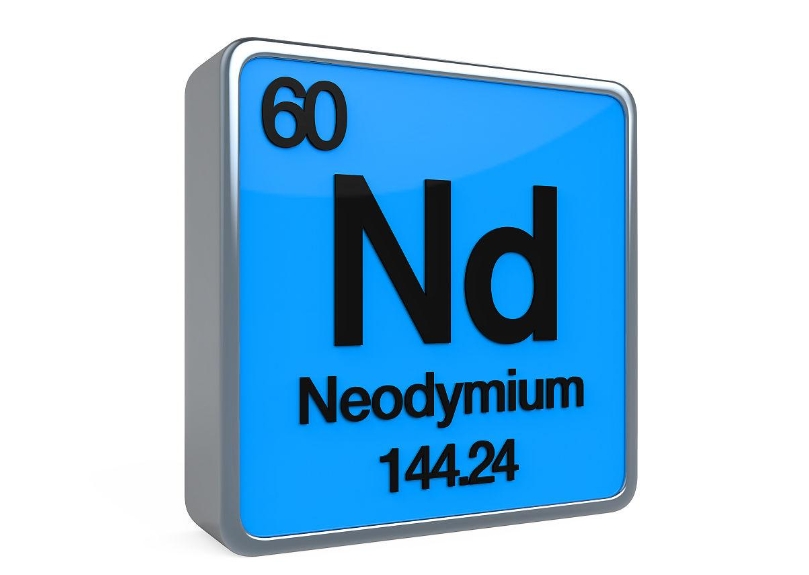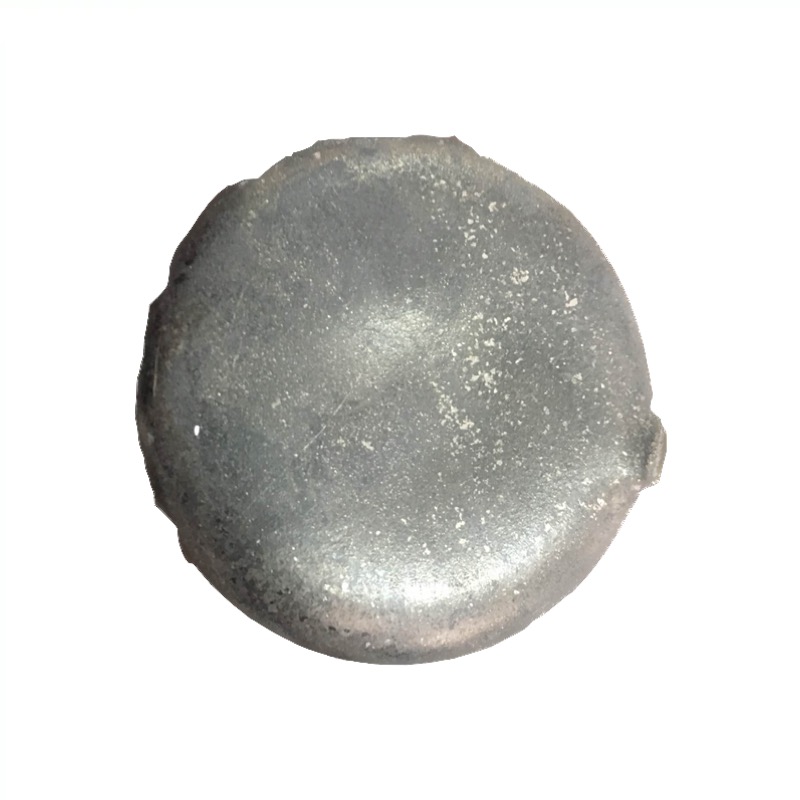Did you know? The element neodymium was discovered in Vienna in 1885 by Karl Auer. While studying ammonium dinitrate tetrahydrate, Orr separated neodymium and praseodymium from a mixture of neodymium and praseodymium through spectroscopic analysis. In order to commemorate the discoverer of yttrium, the German chemist Welsbach, Orr named neodymium "Neodymium", derived from the Greek words "neos" meaning "new" and "didymos" meaning "twins".
After Orr discovered the element neodymium, other chemists were skeptical of the discovery. However, in 1925, the first pure sample of the metal was produced. In the 1950s, the Lindsay Chemical Division
Conducted commercial purification of neodymium through ion exchange methods.
For some time after the discovery of neodymium, it was not widely used. However, with the development of science and technology, neodymium element has begun to be used in many fields due to its unique physical and chemical properties. In the 1930s, commercial neodymium was used as a glass dye, and neodymium glass was used to create reddish or orange-hued glass.
Neodymium has attracted much attention due to its unique physical and chemical properties. Especially in recent years, the application of neodymium in many fields has continued to expand, and its value has become increasingly prominent. So, what is so unique about neodymium? Today, let us uncover the mystery of neodymium.
Application fields of neodymium element
1. Magnetic materials: The most common application of neodymium is in the manufacture of permanent magnets. In particular, neodymium iron boron magnets (NdFeB) are among the strongest known permanent magnets. These magnets are widely used to convert and store energy in devices such as motors, generators, magnetic resonance imaging equipment, hard drives, speakers and electric vehicles.
2. NdFeB alloy: In addition to being used in permanent magnet materials, neodymium is also used to make NdFeB alloy, which is a high-strength, lightweight structural material used to make aircraft engines, automobile parts and other high-performance materials. Strength application.
3. Neodymium-iron alloy: Neodymium can also be alloyed with iron to make high-performance magnetic materials, such as in motor and generator applications in electric vehicles.
4. Water treatment: Neodymium compounds can be used in water treatment, especially to remove phosphates in purified wastewater. This has important implications for environmental protection and water resources management.
5. NdFeB powder: Neodymium plays an important role in the manufacture of NdFeB powders, which are used in the production of permanent magnets.
6. Medical applications: Although not the primary application area, neodymium is also used in some medical equipment, such as magnetic resonance imaging (MRI) machines.
7. Neodymium compounds: Neodymium compounds are also used in some high-temperature alloys and catalysts.
The unique magnetic and chemical properties of neodymium make it widely used in many fields, especially in electronics, energy and materials science.
Physical properties of neodymium Neodymium chemical symbol: Nd, atomic number: 60. It is a rare earth element with a series of unique physical properties. The following is a detailed introduction to the physical properties of neodymium:
1. Density: The density of neodymium is about 7.01 g/cubic centimeter. This makes it lighter than many other metallic elements, but still relatively dense.
2. Melting and boiling points: The melting point of neodymium is approximately 1024 degrees Celsius (1875 degrees Fahrenheit), while the boiling point is approximately 3074 degrees Celsius (5565 degrees fahrenheit). This indicates that neodymium has relatively high melting and boiling points, making it stable in high-temperature environments.
3. Crystal structure: Neodymium will exhibit different crystal structures at different temperatures. At room temperature, it has a hexagonal closest-packed structure, but changes to a body-centered cubic structure when the temperature is raised to about 863 degrees Celsius.
4. Magnetism: Neodymium is paramagnetic at room temperature, which means it is attracted to external magnetic fields. However, when cooled to very low temperatures (about -253.2 degrees Celsius or -423.8 degrees Fahrenheit), it becomes antiferromagnetic, exhibiting the opposite properties of regular magnetism.
5. Electrical conductivity: Neodymium is a relatively poor conductor of electricity, with low electrical conductivity. This means that it is not a good conductor of electricity and is not suitable for applications such as electronic wires.
6. Thermal conductivity: Neodymium also has a relatively low thermal conductivity, making it unsuitable for thermal conductivity applications.
7. Color and luster: Neodymium is a silver-white metal with a bright metallic luster.
8. Radioactivity: All rare earth elements have some radioactivity, but neodymium is very weakly radioactive, so the radiation risk to humans is very low.
The physical properties of neodymium make it valuable in specific applications, particularly in the manufacture of ferromagnetic materials and high-temperature alloys. Its paramagnetic and antiferromagnetic properties also make it of certain importance in the study of magnetic materials and quantum materials.
Chemical properties of neodymium
Neodymium (chemical symbol: Nd) is a rare earth element with a series of special chemical properties. The following is a detailed introduction to the chemical properties of neodymium:
1. Reactivity: Neodymium is a relatively active type of rare earth elements. In the air, neodymium reacts quickly with oxygen to form neodymium oxides. This makes neodymium unable to keep its surface bright at room temperature and will oxidize rapidly.
2. Solubility: Neodymium can be dissolved in some acids, such as concentrated nitric acid (HNO3) and concentrated hydrochloric acid (HCl), but its solubility in water is low.
3. Compounds: Neodymium can form a variety of compounds, usually with oxygen, halogen, sulfur and other elements to form compounds, such as oxides, sulfides, etc.
4. Oxidation state: Neodymium usually exists in the +3 oxidation state, which is its most stable oxidation state. However, under certain conditions, the +2 oxidation state can also be formed.
5. Alloy formation: Neodymium can form alloys with other elements, especially with metals such as iron and aluminum to form neodymium alloys. These alloys often have important applications in magnetic and structural materials.
6. Chemical reactivity: Neodymium can serve as a catalyst or participate in the reaction process in some chemical reactions, especially in the fields of high-temperature alloys and materials science.
7. Oxidizing property: Due to its relatively active nature, neodymium can act as an oxidizing agent in some chemical reactions, causing other substances to lose electrons.
The chemical properties of neodymium make it play an important role in specific application fields, especially in magnetic materials, high-temperature alloys and materials science research.
Biological Properties of Neodymium
The application of neodymium in the biomedical field is relatively limited because it is not an element required in living organisms and its radioactivity is weak, making it unsuitable for nuclear medicine imaging. However, there are some research and application areas involving neodymium. The following is a detailed introduction to the biomedical properties of neodymium:
1. Magnetic resonance imaging (MRI) contrast agent: Although not a commonly used clinical contrast agent, neodymium can be used Prepare MRI contrast agent. Combining neodymium ions into specific molecular structures can enhance the contrast of MRI images, making certain tissues or lesions easier to observe. This application is still in the research stage but has potential for biomedical imaging.
2. Neodymium Nanoparticles: Researchers have developed neodymium-based nanoparticles that could be used for drug delivery and cancer treatment. These nanoparticles can be introduced into the body and then release drugs within recipient cells or perform treatments such as heat therapy. The magnetic properties of these particles can also be used to guide and monitor the course of treatment.
3. Tumor treatment: Although not a direct treatment, research shows that neodymium magnets can be used in conjunction with other treatments, such as magnetic heat therapy. In this method, neodymium magnet particles are introduced into the body and then heated under the influence of an external magnetic field to destroy tumor cells. This is an experimental treatment and is still being studied.
4. Research tools: Some compounds of the element neodymium can be used as experimental tools in biomedical research, such as in the study of cell and molecular biology. These compounds are commonly used to study areas such as drug delivery, bioanalysis, and molecular imaging.
It should be noted that the application of neodymium in the biomedical field is relatively new and is still under continuous development and research. Its applications are limited by its rare earth and radioactive properties and require careful consideration. When using neodymium or its compounds, safety and ethical guidelines must be followed to ensure that they have no negative effects on humans and the environment.
Natural distribution of neodymium
Neodymium is a rare earth element that is relatively widely distributed in nature. The following is a detailed introduction to the distribution of neodymium in nature:
1. Existence in the earth’s crust: Neodymium is one of the rare earth elements present in the earth’s crust, and its abundance is approximately 38 mg/kg. This makes neodymium relatively abundant in the earth's crust, ranking second among rare earth elements, after cerium. Neodymium occurs in much higher abundance than some common metals such as tungsten, lead and tin.
2. In rare earth minerals: Neodymium usually does not exist in the form of free elements, but in the form of compounds in rare earth minerals. Neodymium is contained in some major rare earth ores such as monazite and bastnäsite. The neodymium in these ores can be separated through smelting and extraction processes for commercial applications.
3. In precious metal deposits: Neodymium can sometimes be found in some precious metal deposits, such as gold, silver, copper and uranium deposits. However, it is usually present in relatively small amounts.
4. Seawater: Although neodymium exists in seawater, its concentration is very low, usually only in the microgram/liter level. Therefore, extracting neodymium from seawater is generally not an economically viable method.
Neodymium has a certain abundance in the earth's crust, but it is mainly found in rare earth minerals. Extracting and isolating neodymium often requires complex smelting and refining processes to meet the needs of commercial and industrial applications. Rare earth elements such as neodymium play important roles in modern technology and industry, so research and management of their supply and distribution are crucial.
Mining, extraction and smelting of neodymium
The mining and production of neodymium is a complex process that usually involves the following steps:
1. Mining of rare earth deposits: Neodymium is mainly found in rare earth ores, such as monazite and bastnäsite. Mining rare earth ores is the first step in the production of neodymium. This involves geological prospecting, mining, excavation and the extraction of ore.
2. Processing of the ore: Once the mining ore is extracted, it needs to go through a series of physical and chemical processing steps to separate and extract rare earth elements, including neodymium. These treatment steps can include comminution, grinding, flotation, acid leaching and dissolution.
3. Separation and extraction of neodymium: After ore processing, the slurry containing rare earth elements usually requires further separation and extraction. This usually involves chemical separation methods such as solvent extraction or ion exchange. These methods allow different rare earth elements to be gradually separated.
4. Refining of Neodymium: Once neodymium is isolated, it usually undergoes a further refining process to remove impurities and improve purity. This can include methods such as solvent extraction, reduction and electrolysis.
5. Alloy preparation: Some applications of neodymium require alloying it with other metal elements, such as iron, boron and aluminum, to prepare neodymium alloys for making magnetic materials or high-temperature alloys.
6. Preparation into products: Neodymium elements can be further used to prepare various products, such as magnets, permanent magnets, magnetic resonance contrast agents, nanoparticles, etc. These products can be used in electronics, medical, energy and materials science fields.
It is important to note that the mining and production of rare earth elements is a complex process that often requires strict environmental and safety standards. In addition, the supply chain of rare earth element mining and production is also affected by geopolitics and market fluctuations, so the production and supply of rare earth elements have attracted international attention.
Detection method of neodymium element
1. Atomic absorption spectrometry (AAS): Atomic absorption spectrometry is a commonly used quantitative analysis method, suitable for measuring the content of metallic elements. By converting the sample to be measured into single atoms or ions, irradiating the sample with a light source of a specific wavelength and measuring the absorption of light, the content of the metal element in the sample can be determined. AAS has the advantages of high sensitivity, good selectivity and easy operation.
2. Spectral scanning method: The spectral scanning method determines the content of elements by measuring the absorption or emission of light at different wavelengths of the sample. Commonly used spectral scanning methods include ultraviolet-visible absorption spectroscopy (UV-Vis), fluorescence spectroscopy, and atomic emission spectroscopy (AES). These methods can measure the content of neodymium in samples by selecting appropriate wavelengths and controlling instrument parameters.
3. X-ray fluorescence spectrometry (XRF): X-ray fluorescence spectrometry is a non-destructive analytical method suitable for measuring elemental content in solids, liquids and gases. This method determines the content of elements by emitting characteristic fluorescence radiation after the sample is excited by X-rays, and measuring the peak position and intensity of the fluorescence spectrum. XRF has the advantages of fast, sensitive and simultaneous measurement of multiple elements.
4. Inductively coupled plasma mass spectrometry (ICP-MS): ICP-MS is a highly sensitive analytical method suitable for measuring trace and ultra-trace elements. This method determines the content of elements by converting the sample to be measured into charged ions, using high-temperature plasma generated by inductively coupled plasma to ionize the sample, and then using a mass spectrometer for mass analysis. ICP-MS has extremely high sensitivity, selectivity and the ability to measure multiple elements simultaneously.
5. Inductively coupled plasma optical emission spectrometry (ICP-OES): The working principle of ICP-OES is to use the excited state atoms and ions in the high-temperature plasma generated by inductively coupled plasma (ICP) to transition and emit specific spectral lines. . Because each element has different spectral lines, the elements in a sample can be determined by measuring these spectral lines
These detection methods can be selected as needed, depending on the sample type, required detection sensitivity and analytical conditions. In practical applications, the most appropriate method can be selected to determine the content of praseodymium based on research or industrial needs.
Specific application of atomic absorption method to measure neodymium element
In element measurement, atomic absorption method has high accuracy and sensitivity, providing an effective means for studying the chemical properties, compound composition and content of elements.
Next, we used atomic absorption to measure the amount of neodymium. The specific steps are as follows:
Prepare the sample to be tested. To prepare the sample to be measured into a solution, it is generally necessary to use mixed acid for digestion to facilitate subsequent measurement.
Choose the appropriate atomic absorption spectrometer. Select an appropriate atomic absorption spectrometer based on the properties of the sample to be measured and the range of neodymium content that needs to be measured.
Adjust the parameters of the atomic absorption spectrometer. According to the element to be measured and the instrument model, adjust the parameters of the atomic absorption spectrometer, including the light source,atomizer, detector, etc.
Measure the absorbance of neodymium. The sample to be tested is placed in the atomizer, and light radiation of a specific wavelength is emitted through the light source. The neodymium element to be measured will absorb this light radiation and produce an energy level transition. The absorbance of neodymium is measured with a detector.Calculate the content of neodymium. Based on the absorbance and standard curve, the content of neodymium element was calculated.
Through the above content, we can clearly understand the importance and uniqueness of neodymium. As one of the rare earth elements, neodymium has unique physical and chemical properties, which make it widely used in modern science and technology. From magnetic materials to optical instruments, from catalysis to aerospace, neodymium plays a key role. Although there are still many unknowns about our understanding and applications of neodymium,with the continuous advancement of science and technology, we have reason to believe that we will be able to understand neodymium more deeply in the future and use its unique properties to bring benefits to the development of human society. Come to more opportunities and blessings.
Post time: Dec-10-2024



